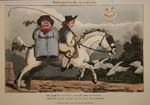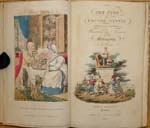Caricature
Caricature and satirical humor were popular throughout the period in which color plate books were popular. Caricature was the reverse of the Romantic illustration that was also en vogue during the nineteenth century, and the two flourished side by side. Styles of caricature changed greatly in the move from the Regency to the Victorian period as public tastes changed. This was an important era for cartoons and humorous newspapers, and political cartoons and caricature were hugely popular, especially during the Regency period. Much of the caricature of this period was considered "coarse" by later Victorian standards. Unlike topography, caricature illustrations are often urban, depicting events and scenes in cities rather than the countryside.

Andrew Chatto, the author of this book, also wrote works on wood engraving and the history of playing cards. The writing style of The Old English Squire was strongly influenced by Sir Walter Scott (Prideaux 305-6) which is unusual for a text illustrated with caricatures and unlike the others mentioned here. The illustrations are in the style of Thomas Rowlandson, although they are nowhere near the quality of his best work.

This is an imitation of Pierce Egan's Life in London, and has plates by numerous illustrators, of which the most important is Henry Alken.

This book was written in imitation of another book of the same title by Alfred Burton, a fact which it made no attempt to hide. The author, John Mitford, had himself been in the navy and was present at the battle of the Nile. The book was part of a vogue for stories which took place in the military.

This was the last book in a great collaboration between the author William Combe and the illustrator Thomas Rowlandson. Combe's death the year after the publication of Johnny Quĉ Genus put an end to the collaboration. The book's introduction indicates that the idea was to produce an English Gil Blas. Gil Blas is a French novel detailing the picaresque adventures of its hero, and was first translated into English by Tobias Smollet. The poem covers the history of its hero, named while his guardian was tipsy, from childhood to adulthood.

This story was not written by William Combe, who originated the Dr. Syntax character. It is probably the best of the many Dr. Syntax imitations that came out in response to the original's popularity. The drawing for the plates have been credited to both Thomas Rowlandson, who illustrated the original Dr. Syntax books, and Robert Cruikshank. The balance of opinion favors Cruikshank, although more than one artist may have worked on the plates (Tooley 352-3).
